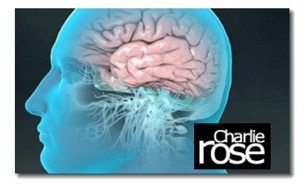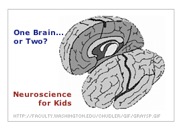Mar 2012
Charlie Rose: Brain Series
2012/03/24 14:52 Filed in: Neuropsychology Neuroscience

- Episode 1 - The Great Mysteries of the Human Brain
- Episode 2 - The Perceiving Brain
- Episode 3 - The Acting Brain
- Episode 4 - The Social Brain
- Episode 5 - The Developing Brain
- Episode 6 - The Aging Brain
- Episode 7 - The Emotional and Vulnerable Brain
- Episode 8 - The Anxious Brain
- Episode 9 - The Mentally Ill Brain
- Episode 10 - The Disordered Brain
- Episode 11 - The Deciding Brain
- Episode 12 - The Creative Brain
- Episode 13 - Highlights from the Series
Seems like a series I want to explore some more. Each episode can be viewed online or purchased as a DVD.
The Split Brain
A news feature at Nature, "The Split Brain: A Tale of Two Halves" should intrigue psychologists and others interested in the development of our understanding of hemispheric dominance in the brain. Written by David Wolman, it describes the role of patients in the 1960s enlisted after their "split brain" operations (cerebral commissurotomies) as Roger Sperry, Michael Gazzaniga, and others learned about the brain's functioning from their responses to testing.
What Happened to the Girls in Le Roy?
Story in the New York Times Sunday Magazine (registration required) about the eruption of tics, writhing, and other manifestations of what might be conversion hysteria in a modern context. The article by Susan Domus begins:
A fascinating story well worth a look….
| "Before the media vans took over Main Street, before the environmental testers came to dig at the soil, before the doctor came to take blood, before strangers started knocking on doors and asking question after question, Katie Krautwurst, a high-school cheerleader from Le Roy, N.Y., woke up from a nap. Instantly, she knew something was wrong. Her chin was jutting forward uncontrollably and her face was contracting into spasms. She was still twitching a few weeks later when her best friend, Thera Sanchez, captain of one of the school's cheerleading squads, awoke from a nap stuttering and then later started twitching, her arms flailing and head jerking. Two weeks after that, Lydia Parker, also a senior, erupted in tics and arm swings and hums. Then word got around that Chelsey Dumars, another cheerleader, who recently moved to town, was making the same strange noises, the same strange movements, leaving school early on the days she could make it to class at all. The numbers grew--12, then 16, then 18, in a school of 600--and as they swelled, the ranks of the sufferers came to include a wider swath of the Le Roy high-school hierarchy: girls who weren't cheerleaders, girls who kept to themselves and had studs in their lips. There was even one boy and an older woman, age 36…" |
Wellcome Collection: Brains
2012/03/10 16:00 Filed in: Neuroscience History

"Our major new free exhibition seeks to explore what humans have done to brains in the name of medical intervention, scientific enquiry, cultural meaning and technological change. Featuring over 150 artefacts including real brains, artworks, manuscripts, artefacts, videos and photography, 'Brains' follows the long quest to manipulate and decipher the most unique and mysterious of human organs, whose secrets continue to confound and inspire. 'Brains' asks not what brains do to us, but what we have done to brains, focusing on the bodily presence of the organ rather than investigating the neuroscience of the mind."
A series of images galleries displays figures which illustrate
- Measuring-Classifying
- Modelling-Mapping
- Cutting-Treating
- Giving-Taking
